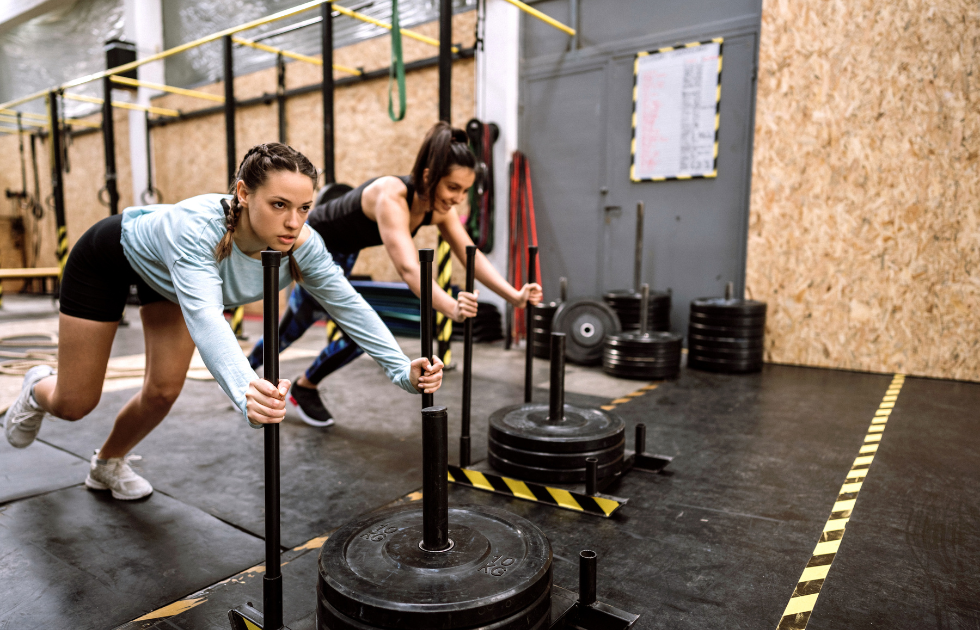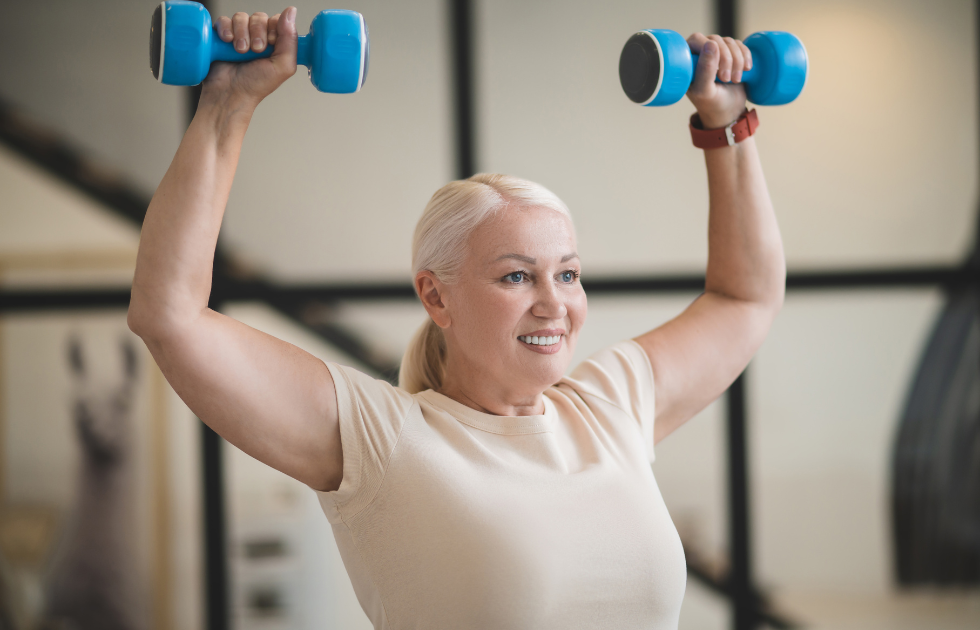Strength training isn’t just for gym junkies or elite athletes.
In physiotherapy, it’s one of the most powerful tools we have to help people manage pain, recover from injury, and build a more resilient body.
Whether you’re dealing with long-standing back pain, recovering from surgery, or simply want to future-proof your body, strength and conditioning (S&C) sits at the heart of modern rehabilitation.

1. Pain doesn’t always mean damage: so we need to move
Pain is a protective response from the nervous system.
It’s influenced by many factors, including tissue sensitivity, previous injuries, stress and beliefs.
In many persistent pain cases, the tissues have already healed, but the nervous system remains sensitised and continues to produce pain in response to normal movement or load.
Avoiding movement may feel safe at first, but over time, it can lead to:
- Deconditioning
- Stiffness
- Reduced confidence in movement
This is where graded exposure and progressive overload become important.
What is graded exposure?
Graded exposure involves gradually reintroducing feared or painful movements, like bending, squatting or lifting, in a safe and modified way.
This helps desensitise the nervous system and rebuild trust in movement.
What is progressive overload?
Progressive overload means slowly increasing the challenge over time, whether through more load, repetitions, range or complexity.
This helps both the body and brain regain capacity.
At Lifecare, we integrate these principles by modifying:
- Load
- Repetitions
- Intensity
- Frequency
- Type of contraction
- Tempo
- Range of motion
For example, physiotherapists often apply S&C principles in low back pain rehabilitation to progressively reintroduce fundamental movements like squatting, hinging, walking and eventually running.

2. Strength training builds resilient tissues
Our muscles, tendons and bones don’t passively recover, they adapt to the loads we place on them through a process known as mechanotransduction.
This makes strength training one of the most effective tools in rehabilitation.
Tendons
Tendons are primarily made of type I collagen and play a critical role in transmitting force between muscle and bone.
In tendon rehabilitation (such as patellar tendinopathy), we use different loading strategies:
- Isometric exercises: helpful in early rehab stages for pain relief
- Eccentric and heavy slow resistance training: to improve tendon structure and load tolerance
- Plyometrics: to reintroduce speed and power, especially for return to sport
Example: A runner with patellar tendinopathy may begin with isometric leg extensions to manage pain, progress to heavy slow split squats, and eventually return to jump-based exercises.
Bones
Bones also respond to loading. High-impact activities encourage bones to become denser and stronger.
Key points about bone loading:
- High-impact (osteogenic) activities like jumping and hopping are more effective than low-impact options
- Short, sharp bursts of impact are enough to stimulate adaptation
- Varied loading is more effective than repetitive load
Example: An athlete with a tibial stress fracture might begin rehab with pool running, before moving on to land drills and impact ladders, and eventually progressing to plyometrics.
Muscles
Muscle tissue adapts to mechanical stress by increasing fibre size, neuromuscular coordination and force production.
For soft tissue injuries like hamstring or calf strains, strength training helps restore both strength and speed – a key factor in sport-specific rehab.
Example: In a hamstring strain, early rehabilitation may include isometric holds and eccentric bridges for pain relief, followed by heavy resistance work, plyometrics and eventually return to sprinting.
3. Conditioning helps you tolerate more in life and sport
Conditioning isn’t just about cardio, it’s about preparing the body to handle effort, fatigue and recovery across all areas of life.
Improving cardiovascular conditioning and general physical preparedness can enhance:
- Work capacity in the gym
- Everyday tasks (such as walking, stair climbing or carrying groceries)
- Return-to-work ability (such as healthcare workers or tradies)
- Sport performance, especially for repeat-effort sports
In persistent pain cases, deconditioning can worsen fatigue and pain sensitivity.
Strategic conditioning can help reverse these effects.
Example: A footballer recovering from a shoulder injury may include upper-body strength circuits, loaded carries and assault bike intervals to rebuild full-body resilience for return to sport.

4. You can reduce pain even without ‘fixing’ the structure
A powerful message we share with our clients: structure does not define function.
Imaging may reveal disc bulges, rotator cuff tears or arthritis, yet many people with these findings improve with the right rehabilitation, even without structural change.
Strength training works through:
- Better movement efficiency and control
- Greater load tolerance
- Activation of the body’s natural pain-relieving pathways
- Improved confidence and independence
Example: A client with a disc protrusion at L5/S1 follows a strength programme and returns to deadlifting after 3 months – with improved function and significantly reduced symptoms, despite no change in imaging.
5. Strength is empowering – for your body and mind
Building strength isn’t just about muscles, it’s about identity, confidence and self-belief.
For athletes, returning to powerful movements (such as jumping, sprinting and cutting) builds psychological readiness alongside physical rehab.
For non-athletes, milestones like walking unassisted, standing on one leg or carrying shopping again are powerful motivators.
Example: An ACL client progresses from crutches to single-leg squats and eventually to advanced agility drills. These visible strength gains and the ability to perform under fatigue build lasting confidence.
Why strength and conditioning matters in physiotherapy
Strength and conditioning isn’t exclusive to bodybuilders or elite athletes, it’s a foundation of evidence-based rehabilitation.
At Lifecare, we use it to:
- Reduce pain and sensitisation
- Build stronger, more resilient tissues
- Help clients tolerate daily demands and return to sport
- Empower individuals to regain confidence in their body
Whether you’re recovering from surgery, managing chronic pain or aiming to future-proof your body, strength training may be your missing link.
Ready to take the next step?
If you’re looking for a structured, personalised approach to rehab or pain management, our physiotherapists are here to support you.
Book online today or find your closest Lifecare clinic to get started.
By Gary Cheung, Physiotherapist – Lifecare Croydon Sports Medicine
Gary is an experienced physiotherapist with a background in both aged care and sports medicine. He takes a holistic and individualised approach to rehabilitation, combining clinical exercise, education and strength-based training. Currently completing post-graduate studies in Sports and Exercise Physiotherapy, Gary also works closely with local sporting clubs and competes in powerlifting at a national level. He is passionate about helping clients bridge the gap between injury recovery and optimal performance.
Further reading
- Bohm, S., Mersmann, F., & Arampatzis, A. (2015). Human tendon adaptation in response to mechanical loading: a systematic review and meta-analysis. Journal of Applied Physiology, 117(3), 271–291.
- Rio, E., Kidgell, D., Purdam, C., et al. (2016). Isometric exercise induces analgesia and reduces inhibition in patellar tendinopathy. British Journal of Sports Medicine, 50(23), 1534–1537.
- Turner, C. H. (1998). Three rules for bone adaptation to mechanical stimuli. Bone, 23(5), 399–407.
- Butler, D. S., & Moseley, G. L. (2013). Explain Pain (2nd ed.). NOI Group.
- Chumanov, E. S., Heiderscheit, B. C., & Thelen, D. G. (2007). The effect of speed and influence of individual muscles on hamstring mechanics during the swing phase of sprinting. Journal of Biomechanics, 40(16), 3555–3562. https://doi.org/10.1016/j.jbiomech.2007.05.026
- Minshull, C. (2020). Conditioning efficacy: A road map for optimising outcomes in performance-based rehabilitation. In S. Porter & J. Wilson (Eds.), A comprehensive guide to sports physiology and injury management (1st ed.). Elsevier.
- Pivonka, P. (Ed.). (2017). Multiscale Mechanobiology of Bone Remodeling and Adaptation. CISM International Centre for Mechanical Sciences, Courses and Lectures (Vol. 578). Springer. https://doi.org/10.1007/978-3-319-43002-3
- Searle, A., Spink, M., Ho, A., & Chuter, V. (2015). Exercise interventions for the treatment of chronic low back pain: a systematic review and meta-analysis. Clinical Rehabilitation, 29(12), 1155–1167.

